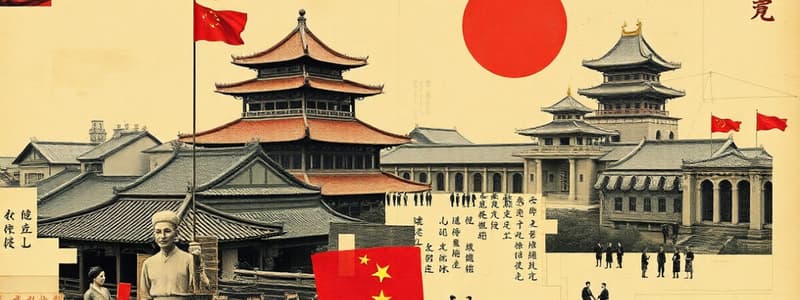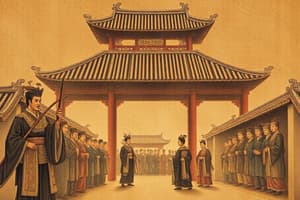Podcast
Questions and Answers
What was a primary characteristic of the Inca civilization's approach to agriculture?
What was a primary characteristic of the Inca civilization's approach to agriculture?
- Private land ownership was common
- Agriculture was controlled by the state (correct)
- Utilization of advanced irrigation techniques
- Decentralized farming methods
Which of the following statements accurately distinguishes the Inca from the Aztecs?
Which of the following statements accurately distinguishes the Inca from the Aztecs?
- The Inca developed a complex writing system.
- The Inca focused on military conquest through superior technology.
- The Aztecs had a separate merchant class, while the Inca did not. (correct)
- The Aztecs incorporated other ethnic groups into their empire peacefully.
What key factor contributed to the decline of the Aztec Empire in the 1520s?
What key factor contributed to the decline of the Aztec Empire in the 1520s?
- The arrival of the Spanish and their superior technology (correct)
- Inability to adapt to new agricultural techniques
- A unified resistance from all native tribes
- Increased trade with neighboring civilizations
Which statement best describes the social structure of the Inca civilization?
Which statement best describes the social structure of the Inca civilization?
How did Cahokia’s societal organization differ from that of the Aztecs and Incas?
How did Cahokia’s societal organization differ from that of the Aztecs and Incas?
What was one consequence of the Spanish conquests for the indigenous populations of the Americas?
What was one consequence of the Spanish conquests for the indigenous populations of the Americas?
Which factor primarily contributed to the impressive agricultural output of the Incas?
Which factor primarily contributed to the impressive agricultural output of the Incas?
What was a notable feature of the political and trade dynamics in Cahokia?
What was a notable feature of the political and trade dynamics in Cahokia?
What was a key factor in the growth of the trafficking commercial center by the 14th century?
What was a key factor in the growth of the trafficking commercial center by the 14th century?
How did wind patterns affect trade in East Africa?
How did wind patterns affect trade in East Africa?
What was a significant aspect of the slave trade in Sub-Saharan Africa?
What was a significant aspect of the slave trade in Sub-Saharan Africa?
What characterized the Chimor Empire's economy?
What characterized the Chimor Empire's economy?
Which method did the Incas use to consolidate their empire?
Which method did the Incas use to consolidate their empire?
What was the significance of the Zanj slave rebellion in the 9th century CE?
What was the significance of the Zanj slave rebellion in the 9th century CE?
What was the primary agricultural technique used by the Andean civilizations to support their economy?
What was the primary agricultural technique used by the Andean civilizations to support their economy?
What major city was associated with the Chimor Empire?
What major city was associated with the Chimor Empire?
Which of the following was NOT a characteristic of the Inca imperial rule?
Which of the following was NOT a characteristic of the Inca imperial rule?
What was a distinguishing feature of the economic systems in the Americas before European contact?
What was a distinguishing feature of the economic systems in the Americas before European contact?
What was Viracocha known as in Inca culture?
What was Viracocha known as in Inca culture?
What was the primary agricultural product cultivated by the Inca Empire?
What was the primary agricultural product cultivated by the Inca Empire?
Which event significantly aided the Spanish conquest of the Inca Empire?
Which event significantly aided the Spanish conquest of the Inca Empire?
What form of tribute system did the Toltecs use?
What form of tribute system did the Toltecs use?
The Aztecs established their capital, Tenochtitlan, on which geographic feature?
The Aztecs established their capital, Tenochtitlan, on which geographic feature?
What was one manner in which Aztec society maintained social order?
What was one manner in which Aztec society maintained social order?
What was the primary role of women in Inca society?
What was the primary role of women in Inca society?
Which of the following characterizes the belief system of the Aztecs?
Which of the following characterizes the belief system of the Aztecs?
What system did the Incas use to manage their conquered subjects?
What system did the Incas use to manage their conquered subjects?
What notable aspect did the Toltecs contribute to later Mesoamerican civilizations?
What notable aspect did the Toltecs contribute to later Mesoamerican civilizations?
What was a significant consequence of the diseases introduced by Europeans to the Inca population?
What was a significant consequence of the diseases introduced by Europeans to the Inca population?
What motivated Aztec warfare and conquests primarily?
What motivated Aztec warfare and conquests primarily?
How did the Inca Empire manage its vast bureaucracy?
How did the Inca Empire manage its vast bureaucracy?
What was an important architectural achievement of the Incas?
What was an important architectural achievement of the Incas?
Flashcards
Sub-Saharan African Trade
Sub-Saharan African Trade
Extensive trade networks involving gold, salt, and enslaved people, connecting East Africa to the Indian Ocean and other regions.
Swahili Coast
Swahili Coast
East African coastal region that served as a major trading hub, acting as intermediaries in long-distance trade.
African Slavery Under Islam
African Slavery Under Islam
Enslavement of Africans was widespread and viewed as a valuable commodity, significantly impacting East and Southern regions.
Chimu Empire
Chimu Empire
Signup and view all the flashcards
Inca Empire
Inca Empire
Signup and view all the flashcards
Incan Imperial Rule
Incan Imperial Rule
Signup and view all the flashcards
Moche Valley
Moche Valley
Signup and view all the flashcards
Chan Chan
Chan Chan
Signup and view all the flashcards
Split Inheritance
Split Inheritance
Signup and view all the flashcards
Pre-Columbian Americas
Pre-Columbian Americas
Signup and view all the flashcards
Inca Empire Similarities to Aztecs
Inca Empire Similarities to Aztecs
Signup and view all the flashcards
Inca vs Aztec Difference in Trade
Inca vs Aztec Difference in Trade
Signup and view all the flashcards
Aztec Decline Cause
Aztec Decline Cause
Signup and view all the flashcards
Aztec Decline Cause 2
Aztec Decline Cause 2
Signup and view all the flashcards
North American Societies Diversity
North American Societies Diversity
Signup and view all the flashcards
Cahokia Significance
Cahokia Significance
Signup and view all the flashcards
North American Societies Trade
North American Societies Trade
Signup and view all the flashcards
Inca/Aztec differences in writing
Inca/Aztec differences in writing
Signup and view all the flashcards
Viracocha
Viracocha
Signup and view all the flashcards
Cuzco
Cuzco
Signup and view all the flashcards
Mita System
Mita System
Signup and view all the flashcards
Quipu
Quipu
Signup and view all the flashcards
Toltecs
Toltecs
Signup and view all the flashcards
Quetzalcoatl
Quetzalcoatl
Signup and view all the flashcards
Aztecs
Aztecs
Signup and view all the flashcards
Tenochtitlan
Tenochtitlan
Signup and view all the flashcards
Tlatoani
Tlatoani
Signup and view all the flashcards
Calpulli
Calpulli
Signup and view all the flashcards
Polytheism
Polytheism
Signup and view all the flashcards
Human Sacrifice
Human Sacrifice
Signup and view all the flashcards
Tribute Empire
Tribute Empire
Signup and view all the flashcards
Precolumbian
Precolumbian
Signup and view all the flashcards
Mesoamerican
Mesoamerican
Signup and view all the flashcards
Study Notes
Ming Dynasty
- Mongols and the Black Death led to the Ming Dynasty's emergence.
- The Mongol Yuan rulers faced chaos and dissent.
- White Lotus Society and Red Turban movements opposed Mongol rule.
- Zhu Yuanzhang established the Ming Dynasty in 1368 (14th century).
- He aimed for a unified China, integrating diverse groups.
- Emperor Hongwu (Zhu Yuanzhang) ruled.
Centralization
- Strong central government was a challenge to rebuild.
- Restoration of respect for rulers was a priority.
- Reconstruction of the bureaucracy, damaged by Mongol rule, took time.
- Emperor Hongwu's marriages to a Red Turban rival (Empress Ma) aimed to unify groups.
- Empress Ma became a more conciliatory figure, but the regime was still authoritarian.
- Emperor Yongle (Hongwu's son) built a grand capital in Beijing, arguably driven by enforced labor.
Bureaucracy
- Favoritism (appointing kinsmen) was initially practiced, but later shifted to merit-based civil service exams.
- Imperial Bureaucrats oversaw administrative tasks, manufacturing, and Confucian ideology.
- The Confucian civil service exam system was reestablished.
- Reforestation and irrigation projects promoted local village networks.
- Bureaucratic hierarchy ensured accountability to the emperor.
- The Ming government relied on local leaders in cities and rural areas for agriculture and control.
- Ruthless tactics (massacre) were used to enforce obedience and maintain control.
Ming Rulership
- Ming stability contrasted with frequent warfare in Europe.
- Building relationships with village chiefs facilitated empire management.
- The Ming had significant influence (10,000-15,000 officials governing 200 million).
- Mongol violence/brutality contributed to Hongwu's actions.
Studying That Suits You
Use AI to generate personalized quizzes and flashcards to suit your learning preferences.




